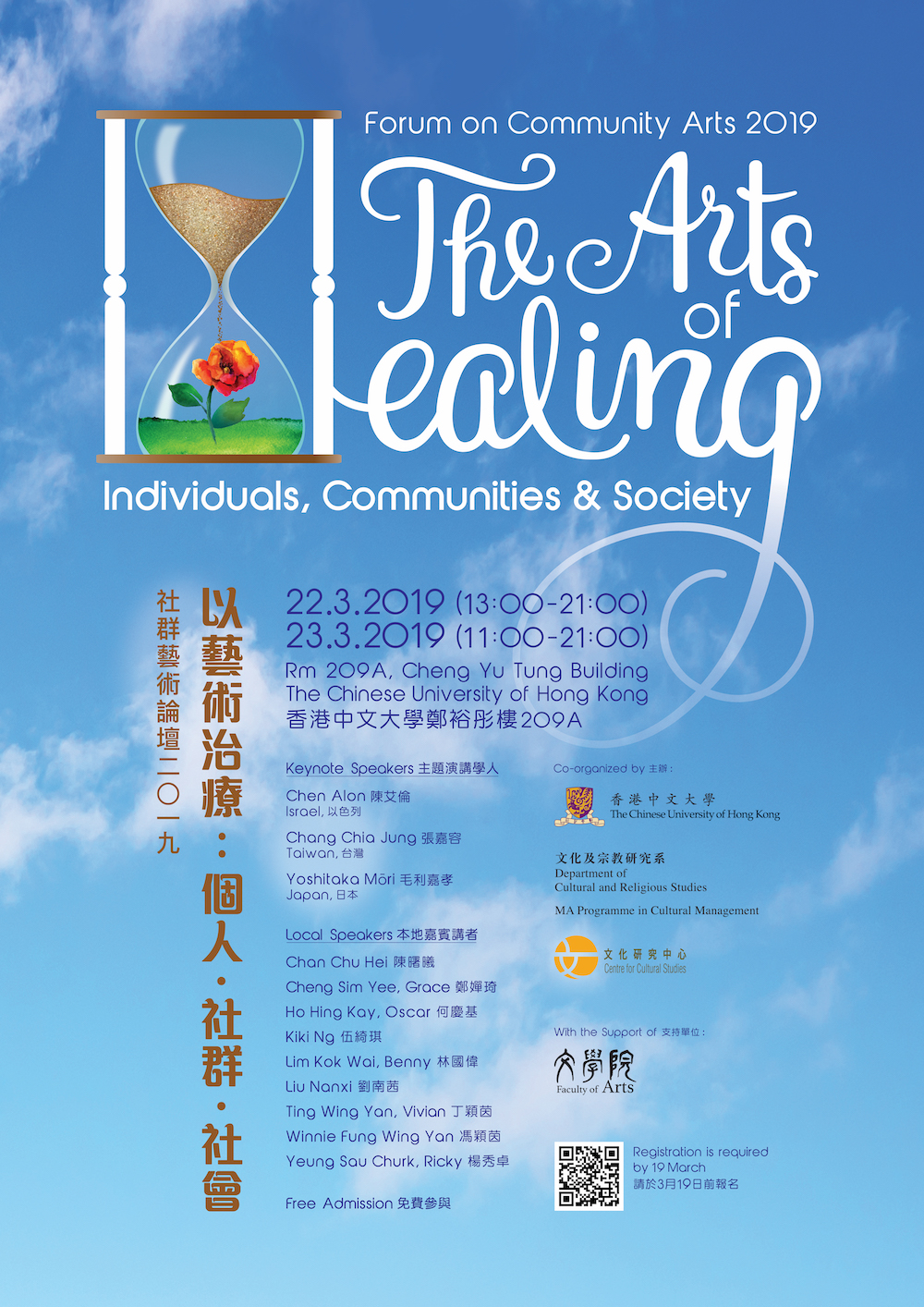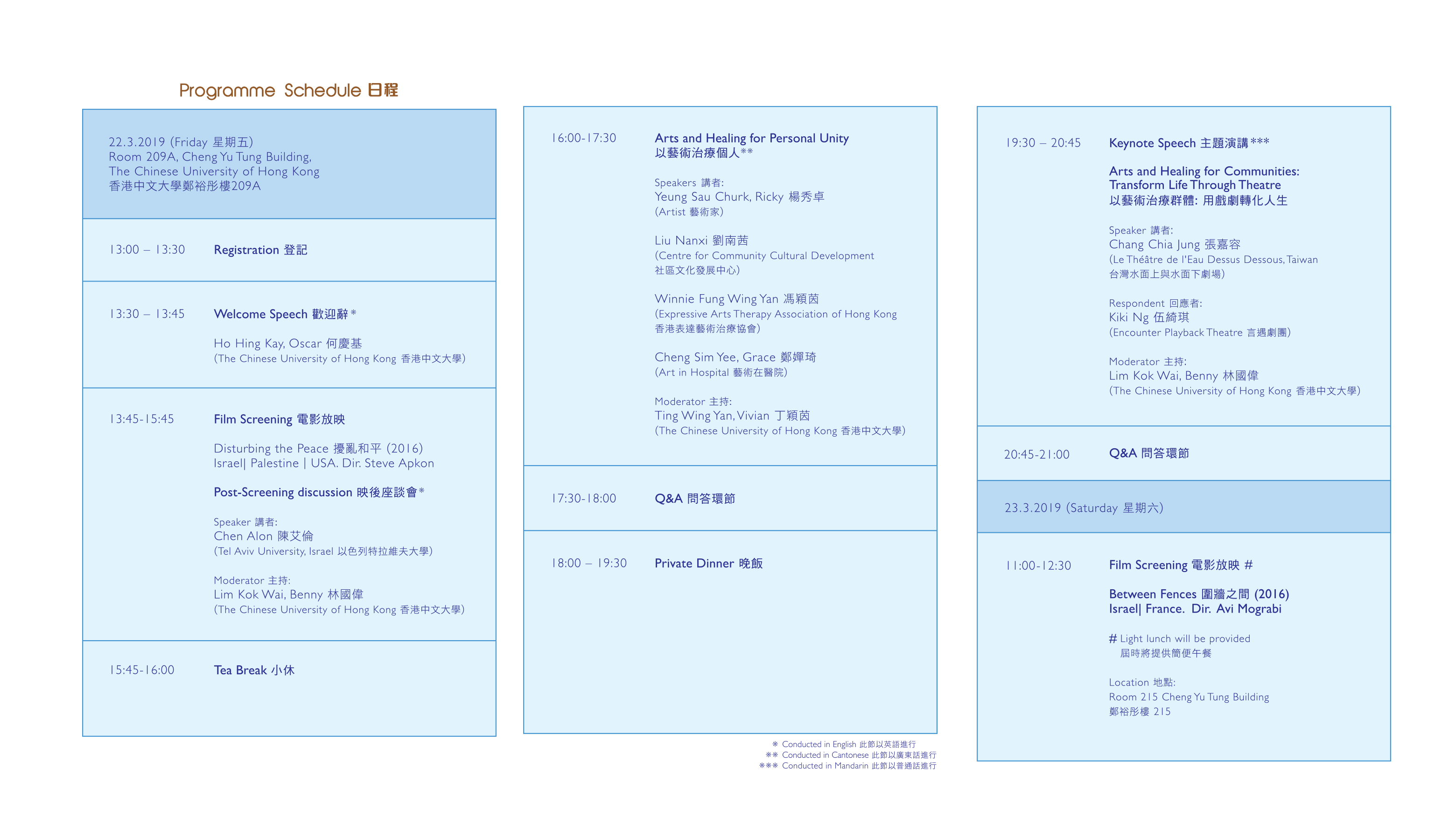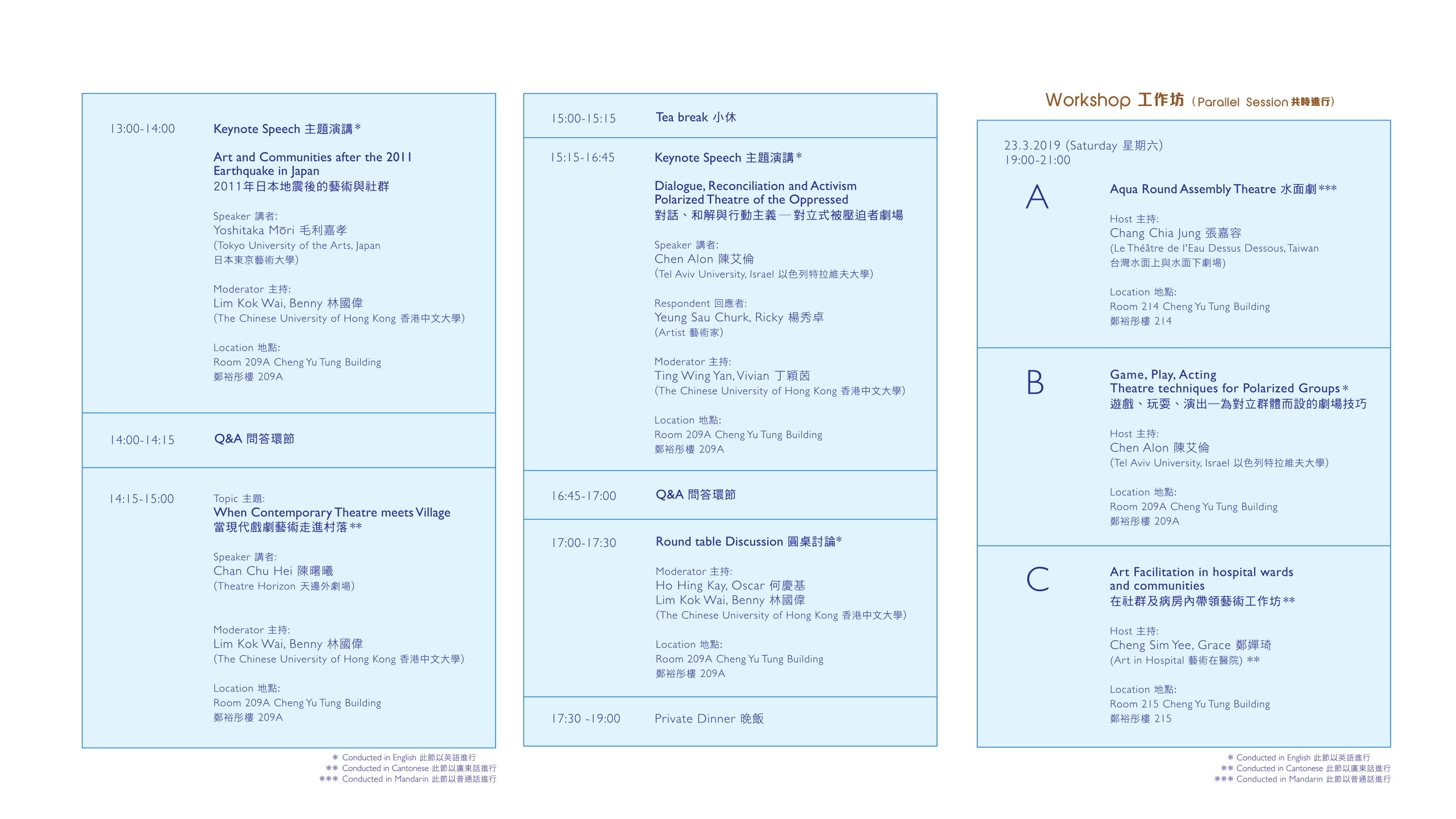
Forum on Community Arts 2019
The Arts of Healing: Individuals, Communities & Society
社群藝術論壇2019
以藝術治療:個人、社群、社會
Many people are wounded in our society: physically and psychologically wounded, wounded by discrimination and misunderstanding, wounded by loneliness, and wounded by a suppressive system…. Arts might not be able to heal all the wounds, but could soothe the pain, rebuild the confidence, break down loneliness and empower one to seek change to heal the wounds. Since 2014 the MA Programme in Cultural Management and the Centre of Culture Studies of CUHK have organized annual forum in community arts, and the topic this year is about the power of arts for personal as well as social healing. Experts from Israel, Japan, Taiwan and Hong Kong will share their knowledge and experience in this area through lecture, discussion and sharing. All interested individuals are welcome.
我們的社會裡,受傷的人比比皆是:身體上受傷、心靈受傷、因歧視和誤解受傷、孤獨的傷害、高壓制度產生的傷害等等……。 藝術或許未能痊癒所有傷口 ,但仍能夠緩解痛楚、重建信心、打破孤寂,為希望扭轉現狀的人充權,為癒合帶來轉機。自二零一四年開始,香港中文大學文化管理碩士課程及文化研究中心每年均舉辦「社群藝術論壇」,探索社群藝術的理念和實踐,促進學術界和社群藝術工作者之間交流,就社群藝術加強本地與海外的溝通和聯繫,從而鼓勵新一代積極參與社群藝術。 本年論壇主題為「以藝術治療:個人、社群、社會」,期望探討藝術的力量,如何在個人層面以至社會層面帶來治療的可能。今年論壇邀請了以色列、日本、台灣和香港的學者和社群藝術工作者,於中文大學以講座、討論、工作坊等形式舉行,歡迎對社群藝術有興趣之公眾人士參與學生參加。
論壇日程 Programme Schedule


Keynote Speech 主題演講
Arts and Healing for Communities: Transform Life Through Theatre
以藝術治療群體: 用戲劇轉化人生
Chang Chia Jung 張嘉容 (Le Théâtre de l’Eau Dessus Dessous, Taiwan 台灣水面上與水面下劇場)
Chang specializes in script writing, directing, and believes theatre can act as a way of healing for people. She developed an interest in exploring the complexity and diverse layers of one’s life and cultural origins. With her collaborations with diverse groups, she created a theatrical model called Aqua Round Assembly Theatre(水面劇). Aqua Round Assembly Theatre is a combination of theatre techniques, counselling and healing practices. Aqua Round Assembly Theatre aims to encourage participants to live out their true selves in their own unique ways. In this presentation, Chang will discuss how Aqua Round Assembly Theatre can help to serve different minority groups. By bringing out their ability to recognize and hold on to the multiplicity of life experiences and humanity, Aqua Round Assembly Theatre allows the participants to experience the power of healing, both individually and collectively.
張嘉容集跨界編導與戲劇療癒工作於一身,致力於探討文化/個人生命課題的複雜度與多義性,創發出「水面劇 (aqua round assembly theatre)」劇場形式及療癒技術。「水面劇」希望聚集人們,引導每個人活出「活水源頭」、特色與主張。 本次演講將圍繞張嘉容如何將工作方法運用在弱勢服務,分享珍貴的影音和案例,說明 「水面劇 (aqua round assembly theatre)」療癒技術裡面的團體療效因子,以及參與者們如何透過戲劇 涵容 (holding)人生與人性。
22.03.2019 | 19:30-21:00
Room 209A, Cheng Yu Tung Building, The Chinese University of Hong Kong
香港中文大學鄭裕彤樓 209A
Conducted in Putonghua 以普通話進行
Dialogue, Reconciliation and Activism – Polarized Theatre of the Oppressed
對話、和解與行動主義 ─ 對立式被壓迫者劇場
Chen Alon 陳艾倫 (Tel Aviv University, Israel 以色列特拉維夫大學)
The Polarized Model of Theatre of the Oppressed was developed in the last two decades in projects that Alon documented and comprehended. At his presentation, Alon will share his experience as a theatre artist and director, facilitator, teacher, political leader, who works with polarized groups from a variety of Israeli and Palestinian sectors, with prisoners, drug addicts, homeless people, asylum-seekers and refugees, as well as in additional conflict zones around the world. The presentation offers a contextualization, examination, deconstruction, and reconstruction of the social relationships as power relations, by means of a theatrical process that considers the unique political connections and context of specific communities. The presentation offers an examination of the potential inherent in the theatrical processes and events
for development of a dialogue on non-violence, while establishing political-activist alliances, with the aim of acting to change the reality.
The Polarized Model posits that the use of theatre is fundamental for an understanding of the creation, development, and preservation of the social power relations between polar groups; and that the representation of both individuals and their “Rainbow of Identities”, materializes and enables an actual visibility of the power relations, and enhances the transformative potential of the two sides.
In this Keynote speech, Alon will present the work that he has done with various groups, such as “Combatants for Peace”, an alliance of Palestinians and Israelis ex-combatants (co-founded by Alon), deploy the practice alongside direct actions and alternative memorial rituals. He will also present and discuss Holot Legislative Theatre, a group he co-founded, composed of African Asylum seekers and Israeli allies. Through Theatre of the Oppressed interactive performances, Holot Theatre aims to arouse public and legal debate leading to political transformation.
過去二十年,陳艾倫一直積極發展一個獨特的劇場模式—對立式被壓迫者劇場(The Polarized Model of Theatre of the Oppressed)。這次主題演講將會從他的個人經驗出發—作為一個劇場藝術家、導演、導師、老師、政治領袖的體會,以及作為一個經常游走於以色列和巴勒斯坦的人,一個常與囚犯、吸毒者、露宿者、尋求政治庇護人士、難民接觸的人,如何把眼前的事物、政治關係、社會關係、權力關係等等以劇場形式呈現,使之處境化,加以分析、拆毀、重塑各個群體的互動及政治聯繫,為敵對群體創造非暴力對話的可能,連結持相近理念的行動者及熱心人士,最終改變社會現實。
對立式被壓迫者劇場相信靈活地運用「劇場」,對於理解「創造」、「發展」等抽象概念非常重要,這種模式相信「劇場」有助保存各個對立群體本來的社群互動經驗、多元的身份象徵(陳艾倫稱之為「身份的彩虹」 (Rainbow of Identities),使本來隱而未現的權力關係被物質化和具體化,繼而發掘出能為雙方帶來各種轉變的可能性。
在這次演講中,他亦會介紹兩個由他與其他組織者一同創立的社區團體:分別是「和平戰士」(Combatants for Peace) 以及 何羅立法劇場 (Holot Legislative Theatre) 。「和平戰士」由一群願意摒棄武力的前巴勒斯坦士兵及前以色列戰鬥人員所組成,多年來期望透過不同社會行動,促使相關群體改為採取非暴力方法溝通。何羅立法劇場 (Holot Legislative Theatre) 則由一群非洲裔的尋求政治庇護者和以色列人組成,成員希望透過運用被壓迫者劇場(Theatre of the Oppressed),引起社會關注以色列境內難民及尋求政治庇護者的人權及生活情況,並展開公共及立法討論,從而帶來具體的政治改變。
23.03.2019 | 15:15-17:00
Room 209A, Cheng Yu Tung Building, The Chinese University of Hong Kong
香港中文大學鄭裕彤樓 209A
Conducted in English 以英語進行
Art and Communities after the 2011 Earthquake in Japan
2011年日本地震後的藝術與社群
Yoshitaka Mōri 毛利嘉孝 (Tokyo University of the Arts, Japan 日本東京藝術大學)
The 2011 Tohoku earthquake, tsunami and the following Fukushima nuclear power plant accidents have changed the life and communities in Tohoku area. Some decided to stay to rebuild their local communities, while others were forced to move out. Just after the earthquake, many artists began to involved with different social and cultural projects from local recovery projects, workshops, media production, art exhibitions to anti-nuclear plant movements. Eight years have since passed. This presentation seeks to examine the current situation of art projects in relation to the 2011 earthquake and critically discuss what art and artists can or cannot do after a disaster.
東日本大震災(又名311地震)之後所引發的海嘯以及福島核電廠輻射洩露等意外,對於日本東北地方居民日常生活及社群帶來前所未有的影響。災後,部分居民決定留守原地,重建社區,另一部分居民則被逼遷離家園。地震之後,很多藝術家積極策動不同的社區文化計劃—由大大小小的本土重建計劃、工作坊、媒體運用及製作項目、藝術展覽,以至反核電廠運動等等,亦可見到眾多藝術家的蹤影。地震發生距今八年,我希望透過檢視日本正在進行的藝術創作和項目,探討這些作品與當年地震的關係,並以批判的角度重新審視藝術作品及藝術家本身在一場災難發生後,能夠或不能夠為社群做些甚麼,以及相隨之而來的影響。
23.03.2019 | 13:00-14:15
Room 209A, Cheng Yu Tung Building, The Chinese University of Hong Kong
香港中文大學鄭裕彤樓 209A
Conducted in English 以英語進行

